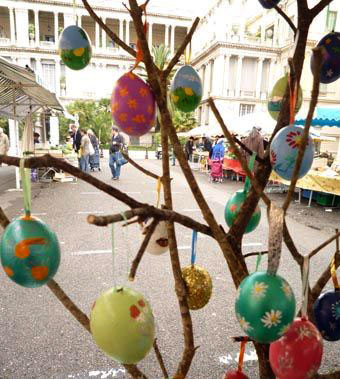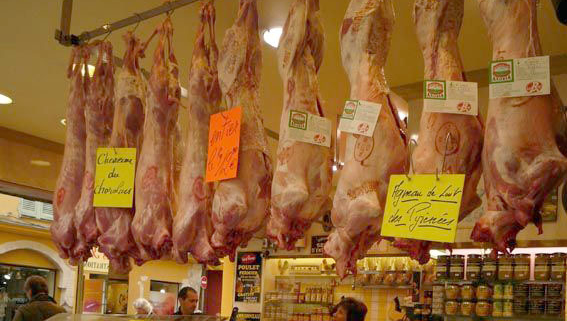Navarin d’agneau – Spring lamb stew
Signs of Easter were everywhere yesterday at the Cours Saleya market. Eggs dangled from an improvised tree at small farmer Dominique’s stand, milk-fed lambs and young goats known as chevreaux hung from hooks at La Poulette, and for the first time this year spring vegetables brightened the market stalls.
 At last, cabbages (beautiful as they are) and Swiss chard are making way for sugary green peas, delicate young fava beans and fat stalks of green asparagus, which here are prized more than the skinny ones. Organic farmer Jean-Louis had a single case of locally grown asparagus that was gone by 8.30am on Saturday; with my one pound of rare stalks (most asparagus sold here comes from the Vaucluse), I felt as lucky as if I had unearthed a black truffle.
At last, cabbages (beautiful as they are) and Swiss chard are making way for sugary green peas, delicate young fava beans and fat stalks of green asparagus, which here are prized more than the skinny ones. Organic farmer Jean-Louis had a single case of locally grown asparagus that was gone by 8.30am on Saturday; with my one pound of rare stalks (most asparagus sold here comes from the Vaucluse), I felt as lucky as if I had unearthed a black truffle.
It was the perfect time to cook navarin d’agneau, a dish that I first came across many years ago while working as an interpreter at the Cordon Bleu cooking school. If I’ve always loved this dish for of all the vivid colors and flavors it unites in a single pot, I felt that I had never found the ultimate recipe: the Cordon Bleu’s version seems just a little too fussy, calling for each vegetable to be blanched or glazed separately before going into the stew (total saucepans: six).
In cases like this I pick up the phone and call Franck. He might be a Michelin three-star chef, but when you get him talking about home cooking all that cheffiness falls away. Forget about cooking each vegetable separately, he told me: instead, add them one by one to the cooking liquid so that they absorb all the flavor. Sure, you can use lamb stock, he said, but failing that chicken stock or even water is fine.
It so happened that when I told my butcher I was making navarin he provided me with a bag of bones along with the shoulder of lamb – milk-fed isn’t necessary here, thankfully – so I was able to make my own stock, a small effort that seemed well worth it.
For the vegetables I chose young carrots, turnips, new potatoes and peas – I could also have used the asparagus, but instead decided to savor its almost nutty flavor at lunchtime with a simple bowl of fluffy quinoa, a squeeze of lemon juice and a drizzling of Nice olive oil. Feel free to the vary the vegetables according to what looks best at the market; in winter, you can make navarin entirely with root vegetables and in summer you can add green beans. Fine quality lamb is essential: mine came from the Alpes de Haute-Provence, a couple of hours from Nice (courtesy of my local butcher, Fulcheri).
Navarin d’agneau
Serves 6
Lamb stock:
About 1 lb (500 g) lamb bones
1 tbsp grapeseed or other neutral-tasting oil
6 cups water (1.5 liters)
1 onion
2 cloves garlic
2 sprigs thyme or savory
Salt and a few fresh black peppercorns
Navarin:
1 lamb shoulder, deboned
Salt and pepper
1 tbsp grapeseed or other neutral-tasting oil
2 cloves garlic
1/2 cup white wine
2 tomatoes, peeled, deseeded and diced, 1 cup chopped canned tomatoes or 2 tbsp tomato paste
4 cups lamb stock, chicken stock or water (1 liter)
A handful of thyme or savory sprigs
16 new potatoes
12 young carrots
8 young turnips
1 lb fresh peas in their pods
For the stock, toss the lamb bones with the oil in a roasting tin and roast in the oven at 425 F (200 C) for about 20 mins, until browned.
Drain off the fat in a colander, place the lamb bones in a saucepan and cover with the water. Add the peeled and quartered onion, crushed garlic with its skin, herbs, salt and peppercorns. Bring to a boil and skim off the foam and fat from the surface. Reduce heat to a simmer and cook for about 1 hour, skimming occasionally. Strain into a bowl through a fine strainer.
For the navarin, cut the lamb shoulder into large cubes, about 2 inches (5 cm). Season the meat all over with salt and pepper. Heat the oil over medium heat in an enamelled cast-iron pot if you have one or a large, heavy saucepan. Brown the lamb on all sides, in two batches if necessary. Slice the garlic thinly and, when the last batch of meat is nearly browned, add to the fat and let it color lightly. Drain the fat off the meat in a colander.
Still over medium heat, deglaze the pot with white wine, scraping the bottom – all the delicious caramelized juices, known as sucs, should dissolve in the liquid. Let the wine bubble for a minute, then add the tomato and let it cook for another minute or two. Add the lamb and stir to coat with the tomato, then add the stock and bring to a boil. Cover the pot and simmer for 40 minutes, either on the stove over very low heat or in the oven at 350 F (160 C).
Meanwhile, prepare the vegetables: peel or scrub the new potatoes, scrub the carrots and cut into diagonal chunks, trim the turnips without peeling them and cut into quarters, and shell the peas. Of these vegetables, Franck says only the turnips need to be cooked separately since they are delicate and could fall apart in the sauce. Cook these in boiling, salted water for 10 minutes, or just until tender. When the lamb has cooked for 40 minutes, add the potatoes and carrots to the liquid. Let these cook for 30 minutes. The lamb should now be tender and the potatoes and carrots cooked – if this is not the case, return to the oven for a few minutes longer. The dish can be prepared ahead up to this point.
A few minutes before serving the stew, add the cooked turnips and fresh peas to the sauce and cook at a simmer until the peas are still bright green but cooked. If you like, you can remove the meat and vegetables to a serving dish and boil the sauce to reduce and thicken it – or just serve it as is, which is what I did this time.





S Lloyd: I’m very happy that the recipe worked for you, particularly as you chose it for your Christmas meal!
Just want tothanks you for this recipe, Rosa: I tried it recently (christmas family meal) and it was successful. Great recipe.
This is just the kind of food I love, Teryll – so I guess it’s lucky I live in France and so near the market! Dishes like this one depend on great ingredients.
This sounds so delicious and satisfying. Simple, classic food that warms your heart and your tummy.